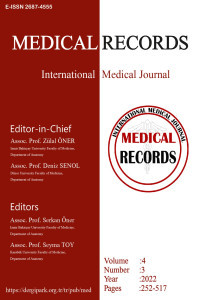Retrospective Analysis of Our Experience with Percutaneous Tracheostomy in Our Intensive Care Unit
Retrospective Analysis of Our Experience with Percutaneous Tracheostomy in Our Intensive Care Unit
complication, tracheostomy, Intensive care unit,
___
- 1. Esteller-Moré E, Ibañez J, Matino E, et al. Prognostic factors in laryngotracheal injury following intubation and/or tracheotomy in ICU patients. Eur Arch Otorhinolaryngol. 2005;262:880-3.
- 2. Duger C, Isbir AC, Uysal IO, et al. The evaluation of the complications of surgical and percutaneous tracheostomies in intensive care unit. Turk J Anaesthesiol Reanim. 2013;41:84-7.
- 3. Pappas S, Maragoudakis P, Vlastarakos P, et al. Surgical versus percutaneous tracheostomy: an evidence-based approach. Eur Arch Otorhinolaryngol. 2011;268:323-30.
- 4. Mota LA, de Cavalho GB, Brito VA. Laryngeal complications by orotracheal intubation: literature review. Int Arch Otorhinolaryngol. 2012;16:236-45.
- 5. Atlas A, Altay N. Our percutaneous tracheostomy experience in our intensive care unit: a retrospective analysis. Harran Üniversitesi Tıp Fakültesi Dergisi. 2021;18:104-8.
- 6. Freeman BD, Isabella KL, Buchman TG. A meta analysis of prospective trials comparing percutaneous and surgical tracheostomy in critically ill patients. Chest. 2000;118:1412-8.
- 7. Antonelli M, Michetti V, Di Palma A, et al. Percutaneous translaryngeal versus surgical tracheostomy: a randomized trial with 1-yr double-blind follow-up. Crit Care Med. 2005;33:1015-20.
- 8. Anon JM, Gomez V, Escuela P, et al. Percutaneous tracheostomy: comparison of Ciaglia and Griggs techniques. Crit Care 2000;4:124-8.
- 9. Rao BK, Pande R, Sharma SC, et al. Percutaneous tracheostomy. Annals of Cardiac Anaesthesia. 2003;6:19-26.
- 10. De Leyn P, Bedert L, Delcroix M. , et al; Belgian Association of Pneumology and Belgian Association of Cardiothoracic Surgery. Tracheotomy: clinical review and guidelines. Eur J Cardiothorac Surg. 2007;32:412-21.
- 11. Ciaglia P, Firsching R, Syniec C. Elective percutaneous dilatational tracheostomy. A simple bedside procedure; preliminary report. Chest. 1985;87:715-9.
- 12. Totoz T, Türk HŞ, Sayın P, Ünsal O, Çınar S, Oba S. Yoğun bakım ünitemizdeki (YBÜ) perkütan trakeotomi pratiğimiz. Ş.E.E.A.H. Tıp Bülteni. 2013;47:11-5.
- 13. Çanakçı E, Şahin AE, Kılıç K. Percutaneous tracheostomy with Grigss dilating forceps technique: Retrospective analysis of 60 intensive care patients. Ege Journal of Medicine. 2016;55:184-9.
- 14. François B, Clavel M, Desachy A, et al. Complications of tracheostomy performed in the ICU: subthyroid tracheostomy vs surgical cricothyroidotomy. Chest. 2003;123:151-8.
- 15. Eminoğlu Ş, Özgünay ŞE, Comparison of percutaneous dilatational tracheostomy via fiberoptic bronchoscopy with standard percutaneous dilatational tracheostomy: a prospective randomized trial. Med Bull Haseki. 2020;58:78-83.
- 16. Öncül S, Yılmaz M, Gaygusuz EA, et al. Our experience in percutaneous tracheostomy which performed by Griggs method: 38 cases. Kocaeli Med J. 2014;3:1-4.
- 17. Ersoy A, Ali A, Ünlü N, et al. 53 percutaneous tracheostomy cases performed with griggs method. Okmeydanı Tıp Dergisi. 2012;28:134-7.
- 18. Destegül D, Kocaöz FŞ, Özkan Kuşcu Ö. Percutaneous and surgical tracheostomy experience in intensive care. Kırıkkale Üni Tıp Derg. 2020;22:192-8.
- 19. Koc A. Percutaneous dilatational tracheostomy with bronchoscopic guidance in intensive care unit. JARSS. 2022;30:245-9.
- 20. Khammas AH, Dawood MR. Timing of tracheostomy in intensive care unit patients. Int Arch Otorhinolaryngol. 2018;22:437-42.
- 21. Yıldırım F, Güllü YT, Demirel CB. Percutaneous tracheostomy in the ıntensive care unit. Eurasian J Pulmonol. 2015;17:136-41.
- 22. Karasu D, Yılmaz C, Baytar Ç, Korfalı G. Retrospective analysis of percutaneous tracheostomi cases in intensive care unit. Turk J Intensive Care. 2018;16:83-7.
- 23. Kearney PA, Griffen MM, Ochoa JB, et al. A single-center 8-year experience with percutaneous dilatational tracheostomy. Ann Surg. 2000;231:701-9.
- 24. Akıncı SB, Kanbak M, Aypar Ü. Perkütan trakeostomi. Yoğun Bakım Dergisi. 2003;3:149-59.
- 25. Shlugman D, Satya-Krishna R, Loh L. Acute fatal haemorrhage during percutaneous dilatational tracheostomy. Br J Anaesth. 2003;90:517-20.
- 26. Ayoub OM, Griffiths MV. Aortic arch laceration: a lethal complication after percutaneous tracheostomy. Laryngoscope. 2007;117:176-8.
- 27. Muhammad JK, Major E, Wood A, Patton W. Percutaneous dilatational tracheostomy: Hemorrhagic complications and the vascular anatomy of the anterior neck. A review based on 497 cases. Int J Oral Maxillofac Surg. 2000;29:217-22.
- 28. Richard SI, James MR. Interventions in intensive care and techniques. 3th edition, Nobel Tıp Kitabevi, 2005;150-9.
- 29. Durbin CG Jr. Early complications of tracheostomy. Respir Care. 2005;50:511-5.
- 30. Süren M, Balta MG, Taş U, et al. Our experiences deal with percutaneous tracheostomy guided with fiber optic broncoscopy. Çağdaş Tıp Dergisi. 2013;3:17-21.
- Yayın Aralığı: Yılda 3 Sayı
- Başlangıç: 2019
- Yayıncı: Zülal ÖNER
lncRNA MALAT1, MEG3, and PANDAR Levels may be Potential Diagnostic Biomarkers in Multiple Myeloma
Elvin ERÖKSÜZ ÖZDİNÇ, Kuyaş HEKİMLER ÖZTÜRK, Fadime MUTLU İÇDUYGU, Demircan ÖZBALCI
Second Allogeneic Stem Cell Transplantation in Acute Leukemia with Post-Transplantation Relapse
Zeynep Tuğba GÜVEN, Serhat ÇELİK, Bülent ESER, Mustafa ÇETİN, Ali ÜNAL, Leylagül KAYNAR
Evaluation of Poisoning Cases Presenting to the Pediatric Emergency Department
İlknur KABA, Samet Can DEMİRBAŞ, Havva Nur Peltek KENDİRCİ
Ahmet YABALAK, Muhammed Nur ÖĞÜN
The Relationship between Spondylolisthesis and Modic Changes: An MRI Study
Veysel DELEN, Alparslan YETİŞGİN, Serap SATIŞ, Safiye KAFADAR, Hamza ERDOĞDU, Saime SHERMATOVA
Invention Arising From Surgical Service Needs; Stoma Bag Cover
Betul GUZELYUZ, Server Sezgin ULUDAĞ
Selim ÇINAROĞLU, Hasan AKKAYA, Hacı KELEŞ, Fatih ÇİÇEK
Mahmut Zabit KARA, Mehmet Hamdi ÖRÜM, Ayşe Sevgi KARADAĞ, Aysun KALENDEROĞLU
